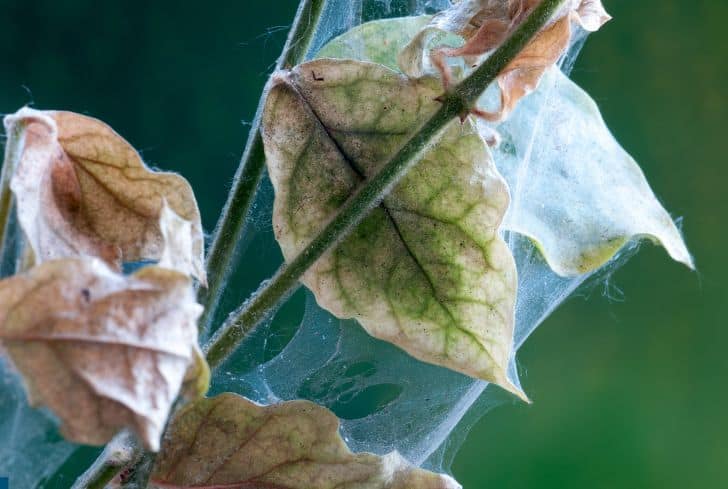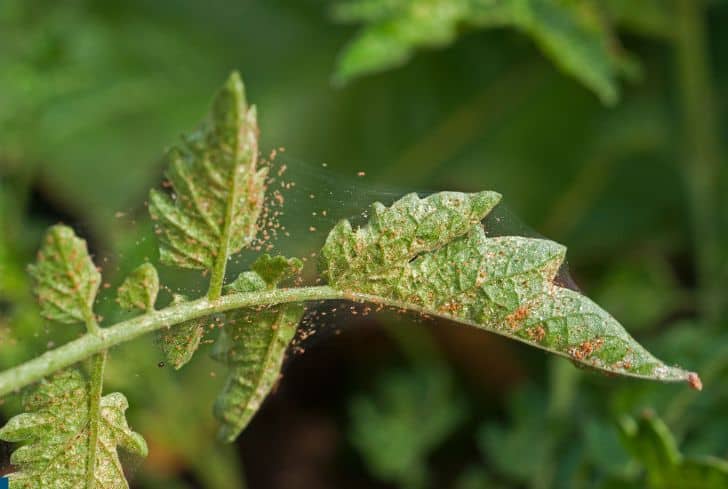Spider mites can cause yellowing and browning of leaves in plants and can cause major havoc to plants if ignored for too long. These tiny creatures are hardly visible to the naked eye unless their population increases tremendously and you notice a large number of leaves dying and falling off.
If you are wondering what are the early signs of spider mites, read our post to know more about the issue and how it can be treated.
What are the First Signs of Spider Mites?
The first signs of spider mites often include silver dots in a pattern, delicate web-like structures, and tiny dots on the leaves and stems. You will notice delicate webs on the undersides of the leaves and corners of the stems. Over time when the mites spread to different plant regions, the shoot tips become bald as the leaves fall and side shoots start to grow as a result.
If you notice white or yellow spots on needles of the plant leaves or bronze-yellow spots on multiple areas of the plant, it could be due to a spider mite infestation.
The discoloration on leaves is initially speckled and becomes more prominent gradually. The leaves rip open between the veins and fall off as a result.
You might have to turn the leaves to check the undersides for webbings and other such early signs. Hold a white paper below the leaf and shake it slightly. You might notice some mites falling on it if the plant is under mite attack. Since they are so tiny, they will be visible only when the population is significantly high.
Can Spider Mites Come Out of Nowhere?
It often appears as though spider mites have appeared out of nowhere but if you observe closely, they might have been around the plants all along. Due to their small size, they go unnoticed and only appear when the weather is warm and suitable for their growth.
Spider mites develop in colonies and appear to the naked eye when their population increases tremendously. As they multiply, multiple plant regions get affected. Most spider mite eggs can be found on leaf undersides where they are protected from direct air and water.
Spider mites are hungry pests and often seem to come out of nowhere. They feed on the plant leaves, piercing through their veins and sucking all plant juices. Other pests like mealybugs also suck plant sap, so make sure you eliminate the possibility of other pest infestation.
Where Do Spider Mites Come From?
Spider mites travel from one place to another with the help of wind. Their lightweight and small size make it extremely easy for them to travel long distances. They can enter your home garden through shoes, clothes, animal fur, and other infected plants. Due to their minuscule size, it becomes difficult to spot these sneaky pests soon.
In spring, female mites lay eggs on the undersides of the leaves and protect themselves with a cocoon. Since spider mites thrive in hot and dry weather, the warmer your region is, the higher are chances of infestations. In favorable weather conditions, they can produce up to seven generations in a year.
What Do Spider Mites Look Like?
Spider mites are eight-legged, tiny creatures that are only visible through a magnifying glass. Use a magnifying glass to accurately determine the presence of spider mites. Without a magnifying glass, they appear as tiny, moving dust particles.
Although they look like spiders, spider mites are not spiders. They are arachnids that feed on juices on leaves and stems. They reproduce quickly and live in colonies. Infected plants are covered by webs spun by mites. The webbing helps protect them from predatory insects and birds.
A spider mite is about one-fiftieth of an inch. It has an oval, translucent, green-colored body with eight legs. Sometimes, the body color varies red to and brown. Under a magnifying glass, you will see two dark spots on its back. In severe infestations, you will only notice white webbings on leaves and stems.
Do Spider Mites Go Away on Their Own?
Due to their extremely small size, spider mites are not easy to get rid of. They will not go away on their own while the plant is alive. You need to take necessary measures to treat the plant and prevent their spread. They will stay on the plant as long as there is something to feed on.
Sometimes, if the infestation is not too severe and the plants are sprayed with water frequently, they might go away. But to ensure that they are gone forever, apply neem oil or soap solution on the leaves and stems regularly. It helps avoid further spread and growth of pests.
Spraying the plant with a garden hose helps remove them from leaf undersides and corners. If the numbers are low, they might go away on their own. But you will need to treat them with a soap solution or an insecticide to control the spread.
Since mites are attracted to dusty plants, we suggest keeping the dust minimum on the plants to prevent them from spreading. Water the plants regularly to prevent dry soil conditions and keep humidity levels high by keeping a humidifier or a humidity tray near plants.

How Quickly Do Spider Mites Spread?
Spider mites are quite small but they can spread rapidly if you ignore the initial symptoms. You can notice them taking over a small plant in as little as two weeks. In about three to four weeks, they can spread to other plants.
So, you have about two weeks before the mites damage the entire plant and spread to other plants in your garden.
In the case of fruit plants and trees, the fruits do not develop fully or fall off prematurely. Spider mites thrive in hot weather conditions with low humidity levels.
In temperatures above 80 degrees Fahrenheit, they become comfortable and start resisting pesticides which is why we recommend using neem oil and other organic methods of mite control as preventive measures and changing the pesticides used from time to time.
Mites do not like dusty conditions which is the reason why we normally do not see them in soil. Leafy plants with high nitrogen, phosphorus, and carbohydrates are their main source of food. They puncture the plant cells and suck out the sap from the leaves.
Once the mites start spreading, they will feed on anything that comes their way including chlorophyll. It is due to this lack of chlorophyll that the plant leaves start turning yellow.
Can a Plant Recover From Spider Mites?
You can make your plant recover from spider mite infestation by treating it at the right time. As soon as you suspect mite infestation, prune and isolate the plant. Prune the affected sections that have webs and throw them immediately to prevent further spread. Disinfect the rest of the plant with neem oil or an insecticide to keep the plant safe from mites.
You can spray the entire plant with plant-based miticides such as neem oil, rosemary oil, pyrethrum, and cinnamite to keep it safe from spider mites in future. Commonly available household items such as alcohol, dish soap solution, and tea miticide also work well in preventing spider mite attacks.
Using diatomaceous earth on affected plants helps dehydrate the mites. Use chemical treatments if it seems difficult for the plant to recover by using methods like miticides and organic pyrethrum. Preventative measures such as introducing predatory insects like lady beetles, lacewings, and wheel bugs also help with early signs of mites.
Quarantine the affected plant as soon as you suspect a spider mite infestation. Leave the plant as separated from other healthy plants as keeping it with other house plants will only increase the chances of them getting infected by mites. If it seems almost impossible to recover the plant from damage, throw it away immediately.
Final Thoughts
Spider mites can be difficult to treat when the infestation is severe. But the sooner you spot them, the easier it will be for you to get rid of these tiny sap-sucking creatures. Treat your plants using biological controls, essential oils, soap and alcohol solutions, diatomaceous earth and insecticidal soaps.
Employ the method that suits your needs and according to the degree of infestation in your plants. Instead of using such treatment methods, we would recommend preventing the problem by keeping the plants healthy and free of pests. Keep the humidity levels high as mites thrive in hot and dry weather.
Identify the early signs of spider mites in your plants with our article and follow the necessary steps to get rid of them. Now that you know all about the early signs of spider mites and their treatment, get going and check your plants for these pests and get rid of them fast.






